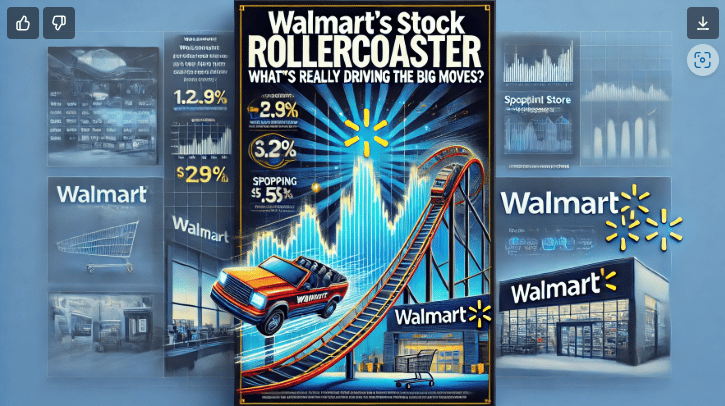- Live Life Grow Wealth
- Posts
- "Walmart’s Stock Rollercoaster: What’s Really Driving the Big Moves?"
"Walmart’s Stock Rollercoaster: What’s Really Driving the Big Moves?"

Today’s Headline
5 Key Insights into Walmart’s Stock Rollercoaster
As an avid follower of the retail industry, I've been closely monitoring Walmart's recent stock performance. The company's shares have experienced notable fluctuations, reflecting a complex interplay of internal strategies and external economic factors. Let's delve into five critical insights that shed light on this rollercoaster ride.
"The most successful investors know that health = wealth—fuel your success with Huel Black Edition. Click here before you miss out!"
You’re Doing Breakfast Wrong
Discover Huel Black Edition—complete nutrition without compromise.
With 40g of protein and 27 essential vitamins, it’s the perfect meal for your busy life. Whether at home or on the go, fuel up in seconds with a high-protein meal.
Even better? New customers get a bundle of savings to kickstart their Huel journey. Use code BEHUEL15 for 15% off your first order, plus a FREE t-shirt and shaker.
1. Conservative Financial Outlook for 2025
In February 2025, Walmart released its financial projections for the fiscal year, anticipating a revenue growth of 3% to 4%. This forecast fell short of analysts' expectations, leading to a 6% drop in the company's share price. The cautious outlook stems from concerns over consumer spending patterns and potential economic headwinds.
Key Points:
Projected Revenue Growth: 3% to 4%
Share Price Impact: 6% decline following the announcement
Underlying Concerns: Consumer spending and economic uncertainties
2. Impact of Tariffs and Trade Policies
The current administration's trade policies, particularly the imposition of tariffs on goods from China, India, Mexico, and Canada, have introduced challenges for retailers like Walmart. These tariffs can lead to increased costs for imported goods, which may affect pricing strategies and profit margins. While Walmart has expressed confidence in managing these duties, the broader economic implications contribute to market volatility.
Key Points:
Affected Imports: Goods from China, India, Mexico, and Canada
Potential Consequences: Higher product costs and adjusted pricing strategies
Company's Stance: Confidence in navigating tariff-related challenges
3. Shifts in Consumer Behavior Amid Inflation
Persistent inflation has altered consumer purchasing habits, with many focusing on essential items and seeking value-oriented retailers. Walmart has benefited from this trend, attracting a diverse customer base, including higher-income shoppers looking for competitive prices. However, the shift towards necessities like groceries, which often have lower profit margins, poses challenges to maintaining overall profitability.
Key Points:
Consumer Focus: Essential goods and value shopping
Demographic Shift: Increased patronage from higher-income customers
Profitability Challenge: Lower margins on staple products
4. E-Commerce Growth and Digital Investments
Walmart's investment in its online platform has yielded positive results, with U.S. e-commerce sales rising by 20% in the recent quarter. This growth underscores the importance of a robust digital presence in meeting evolving consumer preferences. The company's focus on enhancing its online infrastructure aims to compete effectively with e-commerce giants and cater to the increasing demand for convenient shopping options.
Key Points:
E-Commerce Sales Increase: 20% growth in the latest quarter
Strategic Focus: Strengthening digital platforms and online services
Competitive Landscape: Positioning against major e-commerce competitors
5. Dividend Increase Amidst Market Fluctuations
Demonstrating financial resilience, Walmart announced a 13% increase in its annual dividend, raising it to $0.94 per share. This marks the 52nd consecutive year of dividend growth, reflecting the company's commitment to delivering shareholder value despite market uncertainties. The decision aims to instill investor confidence and highlight Walmart's stable financial foundation.
Key Points:
Dividend Growth: 13% increase to $0.94 per share
Historical Consistency: 52 years of consecutive dividend hikes
Investor Assurance: Emphasis on financial stability and shareholder returns
Final Takeaways
Walmart's recent stock fluctuations are a testament to the dynamic nature of the retail sector, influenced by economic policies, consumer behavior, and strategic corporate decisions. As the company navigates these challenges, its focus on digital expansion and maintaining financial health remains evident.
Advice to Subscribers:
Stay Informed: Regularly monitor updates on trade policies and economic indicators that could impact retail stocks.
Evaluate Investment Goals: Consider how Walmart's strategic initiatives align with your long-term investment objectives.
Diversify Holdings: Mitigate potential risks by maintaining a diversified investment portfolio across various sectors.
By keeping abreast of market developments and assessing your financial goals, you can make informed decisions regarding your investments in the retail industry.
[Live Life Grow Wealth]
DISCLAIMER
I make no representations, warranties, or guarantees, whether expressed or implied, that the content provided is accurate, complete, or up-to-date. Past performance is not indicative nor a guarantee of future returns.
I am an individual content creator and not regulated or licensed by the Monetary Authority of Singapore (MAS) as I do not provide investment services.
All forms of investments carry risks, including the risk of losing your entire invested amount. Such activities may not be suitable for everyone. You are strongly encouraged to seek advice from a professional financial advisor if you have any doubts or concerns.

